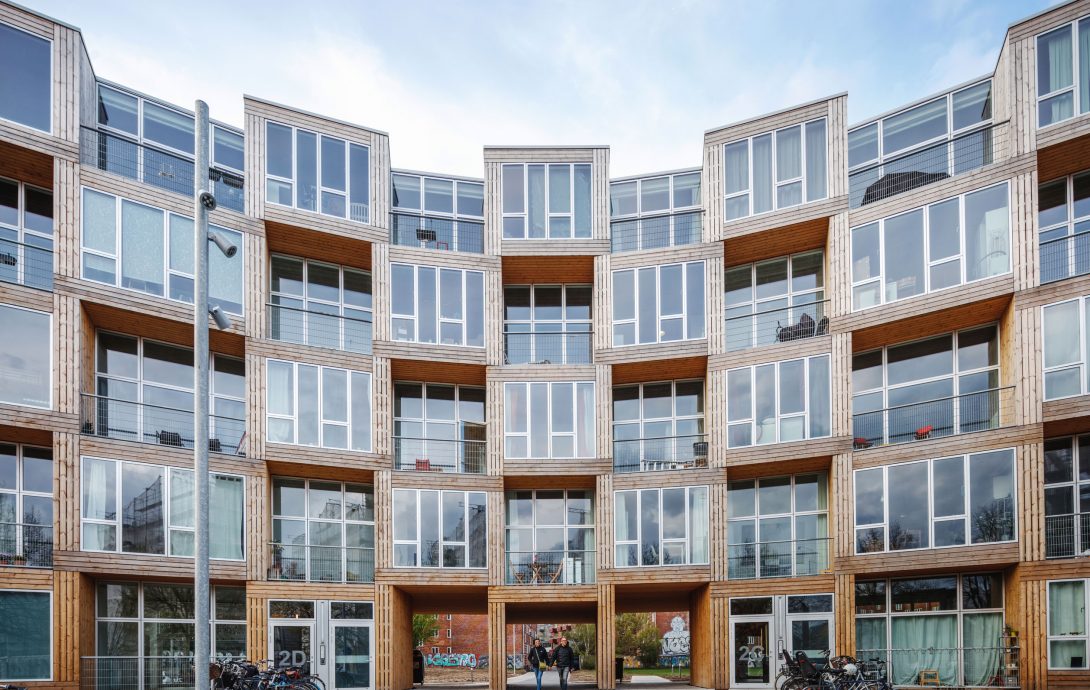
The housing crisis is a pervasive and complicated challenge, impacting communities across the United States. For millions of Americans, the dream of an affordable, stable home is increasingly out of reach, leading to high costs, long commutes, overcrowding, or even homelessness. This isn’t just an economic issue; as Jonathan Curtis, founder and CEO of Cedar Street Partners, highlights, “When people can’t afford stable housing, everything else becomes more difficult: Finding and keeping a job, accessing healthcare, caring for children and building generational wealth. Housing underpins opportunity, and right now, the foundation is cracking.”
Indeed, a recent report from the McKinsey Institute for Black Economic Mobility revealed a stark reality: the United States faced a shortage of over eight million housing units in 2023. This shortage disproportionately affects Black Americans, with 60 percent of Black renters and 30 percent of Black homeowners facing severe cost burdens, significantly higher than national averages. The urgency for action is undeniable, and solving this complex problem demands a multifaceted approach, bringing together a broad set of stakeholders from public, private, and philanthropic sectors.
“Real change requires collaboration among all stakeholders, as no single solution can solve the crisis alone,” states Kelsey Muller, McKinsey associate partner and report coauthor. The good news is that there are concrete, evidence-based strategies we can pursue. These solutions offer a roadmap to not only address the immediate challenges but also to build a more equitable and sustainable housing future for all. Let’s delve into the first seven innovative approaches that promise to make a real difference in the fight against housing insecurity.

1. **Reimagine Land Use Policies**The current housing crisis is deeply intertwined with outdated land use policies. These local and state-level laws govern where, how large, and how dense housing can be built. Historically, such policies have often been used to restrict affordable housing development and perpetuate racial and economic segregation. The consequences are clear: unchecked urban sprawl, increased traffic congestion, and growing pollution.
To truly address the core of the problem, we must fundamentally reimagine how we utilize our land. This involves a shift towards policies that actively promote healthy, affordable homes and foster inclusive communities. It’s about breaking free from the limitations of the past that have exacerbated housing scarcity and inequality.
The “Roadmap Home 2030” initiative by Housing California emphasizes the necessity to “Reimagine Growth.” This means critically evaluating existing zoning restrictions that limit new construction and housing density, which are frequently cited as primary culprits in the housing shortage. While zoning reforms are recognized as effective, their implementation has historically faced significant opposition, limiting their scope and impact.
Read more about: Inside Qantas’ Incredible Flight: Transporting a Jet Engine on the Wing of a 747
2. **Incentivize Zoning Reform with Direct Financial Benefits**Overcoming community opposition to zoning reform is one of the most significant hurdles to increasing housing supply. Traditional methods, such as offering indirect financial incentives for communities to fund high-density development, have often fallen short. As the context illustrates, a Massachusetts town chose to forgo over $140,000 in state funding for public projects, including a seawall, rather than comply with mandatory state zoning changes aimed at creating affordable housing. This demonstrates that indirect benefits are often not compelling enough.
A novel and potentially more effective approach is to provide direct financial benefits to residents. This strategy involves putting money directly into the pockets of local citizens, creating a tangible, personal stake in supporting new development. By making the benefits direct and personal, the resistance to changes that increase housing density in neighborhoods could be significantly reduced.
This concept draws inspiration from models where citizens have directly benefited from resource development, such as Alaskans approving a pipeline because they received a share of the profits. If dividends from tax revenues generated by new housing developments were distributed straight to residents, rather than indirectly benefiting them through municipal coffers, it could create the necessary incentive for communities to embrace and champion more housing and density. This transforms a collective benefit into a personal one, potentially shifting public perception and support.
Read more about: America’s Housing Conundrum: A Deep Dive into the Systemic Roots of Unaffordability and the Fading Dream of Homeownership

3. **Augment Programs to Unleash Private Capital**Developing affordable housing is a capital-intensive endeavor, frequently requiring a blend of subsidies and innovative financing structures. However, traditional financial institutions are often not optimally structured to support these unique financing needs, leading to a chronic shortage of capital for affordable housing developers. Community Development Financial Institutions (CDFIs), which specialize in serving low-income communities and nonprofits, face immense demand they often cannot meet. More than half of these crucial organizations report an inability to keep up with the financing needs.
A significant challenge for CDFIs is the limited secondary loan market. A robust secondary market allows CDFIs to sell existing loans to investors, which in turn replenishes their capital. With fresh capital, these institutions can then reinvest in and finance a new wave of affordable housing developments, creating a continuous flow of funding for projects that desperately need it. Without this mechanism, CDFIs are often constrained by their balance sheets, hindering their ability to scale their impact.
One promising solution involves bundling CDFI loans into portfolios that meet the requirements of the Community Reinvestment Act (CRA). The CRA is a federal law that incentivizes banks to meet the financial needs of their communities, including low-income areas. By structuring CDFI loans in this manner, they become more attractive to banks, strengthening the secondary loan market and unlocking substantial private capital. The non-profit Scale Link is already demonstrating this success, having purchased approximately 3,500 loans from CDFIs, sold nearly $37 million to bank partners, and provided $55 million in new capital. This model effectively bridges the gap between affordable housing financing needs and the private sector’s investment capacity.
Read more about: Russia’s Unprecedented Barrage: A Deep Dive into the Record 6,400 Drones and Missiles Launched into Ukraine Last Month
4. **Scale Off-Site Home Construction**The current housing crisis is severely exacerbated by escalating material costs and a national labor shortage, both of which drive up housing prices. To mitigate these pressures, finding faster and more efficient construction methods is paramount. Off-site home construction, where building components are manufactured in a factory setting and then assembled at the final site, presents a compelling solution. This method is typically more cost-effective than traditional on-site construction due to economies of scale and reduced waste.
Despite its inherent advantages, off-site construction has struggled to achieve widespread adoption and scale. A primary impediment is the highly fragmented and complex permitting process, which varies significantly from one state and city to another. Every hour consumed in navigating these intricate permitting and development procedures translates directly into increased costs for builders, which are ultimately passed on to consumers in the form of higher housing prices. The inconsistencies create a bureaucratic maze that stifles innovation and efficiency.
For off-site construction companies, the burden of differing codes is substantial. They must invest considerable resources in understanding diverse local regulations, constantly adapt their production processes, and address potential compliance issues unique to each jurisdiction. Standardizing state and local building codes would significantly remove these roadblocks, streamlining the approval process and dramatically shortening construction timelines. This strategic shift would enable off-site construction to fulfill its potential as a critical tool for rapidly and affordably increasing housing supply.

5. **Reinvest in Public Housing through Conversion and Private Investment**Public housing, once a cornerstone of affordable living, now faces a staggering $115 billion backlog in funding for essential safety and quality improvements. This dire situation highlights the urgent need to bring more units back online and ensure they are habitable. One innovative strategy to address this immense funding gap is the conversion of Section 9 public housing, which is primarily federally funded, to Section 8 voucher-based housing. This conversion opens the door to private investment, allowing commercial landlords and other private and government sources to contribute capital for rehabilitation and ongoing maintenance.
However, Public Housing Authorities (PHAs) often encounter significant challenges in facilitating these conversions. They frequently lack the necessary technical capacity and expertise to manage complex financial transactions, particularly when rehabilitation costs are substantial. This institutional limitation prevents many PHAs from effectively leveraging the opportunities presented by Section 8 conversions, leaving a vast number of public housing units in disrepair or out of commission.
Providing better access to specialized technical assistance and sophisticated financial tools is crucial for empowering PHAs to navigate these conversions successfully. By equipping them with the resources to undertake and manage more conversion projects, we can attract vital private capital to revitalize public housing. This approach not only addresses the immediate repair backlog but also creates a more sustainable funding model for maintaining these critical affordable housing assets, ensuring they serve low-income residents for the long term.
6. **Expand Shared-Equity Models like Community Land Trusts (CLTs)**Beyond traditional public housing, innovative shared-equity housing solutions offer a powerful pathway to creating lasting affordability and fostering wealth for residents. Nonprofits play a pivotal role in these models, particularly through Community Land Trusts (CLTs). In a CLT model, a non-profit organization typically acquires land, develops new housing units, or purchases existing properties. This land is then placed into a trust, which is managed by community members. The core principle of a CLT is to permanently separate the cost of the land from the cost of the housing, ensuring that homes remain affordable for future generations.
This separation of land and housing costs makes homeownership accessible to low-income households, who might otherwise be priced out of the market. When a CLT home is resold, its price appreciation is limited, ensuring that the affordability is preserved for the next buyer. This mechanism directly combats speculative real estate practices that drive up housing prices, contributing to long-term community stability and preventing displacement.
Expanding shared-equity models like CLTs is a crucial step towards building generational wealth for residents who participate. It provides a stable asset that grows modestly in value, offering a form of equity building without the volatile risks of the speculative market. By supporting and scaling these nonprofit-led initiatives, communities can create a resilient stock of affordable housing that serves the needs of its residents for decades to come, fostering economic opportunity and social inclusion.

7. **Revamp Housing Choice Vouchers with Direct Assistance and Streamlined Processes**The Section 8 Housing Choice Voucher program is the largest source of rental assistance in the United States, yet its full potential remains untapped. Despite their availability, a disheartening statistic reveals that only one in four eligible families actually use housing vouchers, and merely 60 percent of those who do manage to secure housing with the assistance. This significant gap underscores systemic inefficiencies and barriers that prevent families from accessing and utilizing this critical support.
A major sticking point in the current system lies with landlords. They often face substantial administrative burdens, including lengthy rent negotiations, delayed subsidy payments, and rigorous inspection processes. These inconveniences can disincentivize landlord participation, with some even resorting to outright discrimination against voucher holders, despite legal protections. The complexities of the program, from a landlord’s perspective, reduce the attractiveness of accepting vouchers.
To truly revamp the program and unlock its potential, several changes are necessary. One radical yet potentially effective idea is to provide rental assistance directly to families, rather than subsidizing the landlord. This could simplify the process for renters and reduce the administrative load on landlords. Additionally, implementing measures to reduce landlord-specific administrative burdens, such as offering upfront security payments, guaranteeing automatic direct deposits for subsidies, and streamlining inspection protocols, could significantly incentivize more landlords to participate in the Section 8 voucher program. These targeted improvements are essential for ensuring that more eligible families can translate their vouchers into stable, affordable homes.
Navigating the complex landscape of housing unaffordability requires a comprehensive suite of solutions, extending beyond the initial strategies we’ve explored. The next eight approaches delve deeper into financial reforms, robust protections for residents, systemic improvements, and targeted program expansions designed to build a more equitable and stable housing future for all. These strategies are not mere theoretical constructs; they are actionable pathways, backed by expert insights, aimed at addressing the multifaceted roots of the crisis and fostering lasting change.

8. **Promote Fairness in Finance Systems and Increase Public Revenue**The journey toward solving the housing crisis fundamentally relies on a robust and reliable financial foundation. While private capital plays a crucial role in development, it must be complemented by significant public investment. Finance policy, at local, state, and federal levels, dictates the funding mechanisms for constructing, preserving, and maintaining affordable housing, as well as supporting vital programs that help people exit homelessness.
To truly address this, communities must critically evaluate and adjust their tax and finance systems to generate the necessary revenue. The ‘Roadmap Home 2030’ initiative underscores this by calling to “Promote Fairness in our tax and finance systems and create the revenue needed to Invest in Our Values.” This principle advocates for a systemic approach where financial structures are aligned with societal goals of housing equity and affordability, ensuring that the burden and benefits of development are distributed equitably.
Ultimately, a commitment to fairness in financial systems translates into a greater capacity to fund evidence-based programs. This ensures that resources are consistently available for building new affordable units, rehabilitating existing ones, and providing essential services that keep people housed and prevent homelessness. Without dedicated public revenue, even the most innovative programs can struggle to achieve the scale necessary to make a significant impact across affected communities.
Read more about: Unmasking the Trust Deficit: Why Car Dealerships Are Struggling to Connect with Today’s Buyers and How They Can Rebuild Confidence

9. **Expand State Affordable Housing Programs and Low-Income Housing Tax Credits**Creating a sufficient supply of affordable housing remains a cornerstone of crisis resolution, especially for low-income individuals and families who are often priced out of conventional markets. This focus extends to providing suitable homes for people experiencing homelessness who do not require intensive supportive services, allowing them to stabilize and rebuild their lives.
Concrete strategies include the “expanding state affordable housing rental and homeownership programs,” as highlighted by the ‘Roadmap Home 2030’. Such expansions are vital for increasing the direct availability of affordable units, whether through rental assistance or accessible homeownership pathways. These programs can be tailored to meet regional needs, addressing specific gaps in housing supply and demand.
One of the most powerful and widely utilized financial tools for incentivizing affordable housing development is the Low-Income Housing Tax Credit (LIHTC) program. Permanently expanding the state LIHTC program would unlock significant investment, making it more attractive for developers to build or rehabilitate properties specifically for low-income residents. This consistent and reliable funding mechanism is essential for sustaining a pipeline of affordable housing projects.
Furthermore, providing targeted funding to local jurisdictions empowers them to implement solutions best suited for their unique challenges. This localized support, combined with policies that allow for denser development in high-opportunity areas, can synergistically increase the overall supply of affordable and mixed-income housing, contributing to more inclusive and vibrant communities.
10. **Implement Robust Resident Protections**Beyond increasing housing supply, safeguarding existing residents from displacement is a critical component of a stable housing ecosystem. Comprehensive resident protections are essential to prevent low-income households from losing their homes and subsequently falling into homelessness. These measures provide a crucial safety net, ensuring that housing stability is maintained even in challenging economic climates.
Key among these protections are “expanding rent control and just cause eviction protections.” Rent control helps to stabilize housing costs, preventing sudden, unaffordable increases that can force families out of their homes. Just cause eviction protections ensure that landlords must have a valid, legally specified reason to evict a tenant, thereby preventing arbitrary or discriminatory displacements that often destabilize communities.
Another vital safeguard is “providing a right to counsel for renters facing eviction.” Many renters, particularly those with low incomes, face eviction proceedings without legal representation, putting them at a significant disadvantage. A right to counsel ensures that tenants have access to legal expertise, dramatically improving their chances of retaining their housing and preventing the cascade of negative consequences associated with eviction. These protections serve as an intervention, acting before a crisis escalates into full-blown homelessness.
Read more about: Understanding Your Rights: What the New Data Privacy Laws Mean for American Consumers

11. **Remove Barriers to Housing Access**Even when affordable housing options are available, systemic barriers can prevent individuals and families from securing them. These obstacles are distinct from tenancy protections, focusing instead on the initial application and screening processes that can disproportionately exclude vulnerable populations. Addressing these barriers is crucial for ensuring that housing programs genuinely reach those who need them most.
Among the most significant barriers are overly stringent or discriminatory screening practices, such as “criminal record searches and credit scores.” While intended to assess risk, these criteria often penalize individuals for past circumstances that may have no bearing on their current ability to be a good tenant. A criminal record, for instance, can be a lifelong impediment to housing, perpetuating cycles of instability and homelessness.
Similarly, low credit scores, often a symptom of past financial hardship or limited access to traditional banking, can automatically disqualify otherwise eligible applicants. These practices effectively create a second tier of exclusion, preventing people from accessing housing even with rental assistance. Removing or significantly modifying these barriers is paramount to creating equitable access, allowing individuals to secure stable housing and move forward with their lives.
Read more about: Navigating Your Future: A Comprehensive Guide to VA Housing Assistance Programs for Veterans
12. **Advance Systemic Structural Reforms**Solving the housing crisis demands more than just isolated programs or new funding streams; it requires fundamental changes to the underlying systems that govern housing and homelessness. Structural reforms are pivotal in transforming the operational frameworks and collaborative efforts used to address these complex issues. This involves a concerted effort among multiple stakeholders to pinpoint and rectify institutional problems that hinder progress.
These reforms aim to improve the intricate web of communication and coordination between various organizations, government agencies, and other stakeholders. By fostering “stronger alignment, consistent compliance, and overall easier access to programs and services,” structural changes can dramatically enhance the efficiency and effectiveness of the entire housing and homelessness response system. The current fragmentation often leads to bureaucratic hurdles, redundant processes, and missed opportunities to connect people with vital resources.
The ‘Roadmap Home 2030’ further emphasizes the need to “Create Efficiency and Accountability by establishing clear leadership, streamlined processes, and seamless coordination.” This holistic approach ensures that resources are utilized optimally, decision-making is coherent, and the system as a whole becomes more responsive to the urgent needs of those struggling with housing insecurity. Such reforms are crucial for translating policy into tangible, on-the-ground improvements.
Read more about: Why Your Road Tax Is Set to Double: An In-Depth Look at America’s Infrastructure Funding Crisis

13. **Expand Permanent Supportive Housing (PSH)**For individuals experiencing chronic homelessness or those with complex needs, Permanent Supportive Housing (PSH) stands out as an evidence-based and highly effective intervention. PSH is defined as permanent, affordable housing that is deliberately accompanied by intensive supportive services. These services can include case management, mental health treatment, substance use counseling, and medical care, all tailored to help residents maintain their housing stability and improve their overall well-being.
The benefits of PSH are substantial and far-reaching, demonstrating an “increase in housing retention and service engagement.” By providing a stable home and integrated services, PSH helps individuals address the underlying challenges that contributed to their homelessness. Moreover, it proves to be less costly for communities in the long run, as housed individuals are significantly less likely to utilize expensive emergency services, hospitals, jails, and emergency shelters. This shift from crisis response to stable living represents a net gain for both individuals and the public purse.
To expand the reach of this vital intervention, the ‘Roadmap Home’ proposes “flexible ongoing funding for local jurisdictions to build supportive housing.” This dedicated and adaptable funding ensures that communities have the resources to develop and sustain PSH programs, making a significant impact on reducing chronic homelessness and fostering healthier, more stable populations.
14. **Enhance and Diversify Rental Subsidies, Including Rapid Rehousing**While the revamp of the Housing Choice Voucher program is critical, a broader and more diversified approach to rental subsidies is essential to fully address the spectrum of housing affordability challenges. Rental subsidies, in various forms, provide crucial assistance to people experiencing or at risk of homelessness, directly bridging the gap between their income and rising rental costs.
These programs can be structured in numerous ways to meet diverse needs. Some might offer a “fixed amount of subsidy,” providing consistent support, while others are “basing it off the household’s income,” ensuring that the assistance adjusts to changing financial circumstances. The flexibility in these structures allows for a more targeted and responsive approach to individual and family needs, making housing more attainable across different income brackets.
A particularly effective model is “rapid rehousing,” a short-term rental subsidy often paired with services. This intervention is designed to move individuals and families experiencing homelessness into permanent housing as quickly as possible. Rapid rehousing programs typically “initially pay the entire rent and then phase out,” providing a crucial period of stabilization while tenants secure employment and build financial independence.
Crucially, these interventions often include “limited ongoing support such as landlord mediation.” This element helps to foster positive landlord-tenant relationships, resolve potential issues, and ensure the long-term success of the tenancy. By enhancing and diversifying rental subsidies, communities can offer a more robust safety net, preventing homelessness and securing stable homes for more people.
15. **Champion the Housing First Framework for Homelessness Solutions**At the heart of any effective strategy to combat homelessness lies a foundational philosophy: Housing First. This framework is not merely an intervention but a guiding principle, recognized as “the only evidence-based framework for solving homelessness.” Its core tenet is elegantly simple yet profoundly impactful: the solution to homelessness is, quite literally, a home.
Housing First “insists that providing a permanent, safe, affordable and immediate home to people experiencing homelessness – without a restricted length of stay – is the surest way to help people exit homelessness.” Unlike traditional models that require individuals to meet certain conditions (e.g., sobriety, employment) before housing is provided, Housing First prioritizes immediate housing, recognizing it as a fundamental human right and a prerequisite for addressing other life challenges. This approach provides the stability necessary for individuals to then engage with services.
It is crucial to understand that “Housing First does not mean housing only.” Services are an integral part of the model, offering comprehensive support once individuals are housed. These services are “critical both to helping people access permanent housing quickly and, for some, providing services to allow people to live independently and stably in housing,” addressing needs related to mental health, substance use, employment, and overall well-being. This integrated approach acknowledges the multifaceted challenges faced by those experiencing homelessness.
As a “guiding principle of the Roadmap Home,” championing the Housing First framework means embedding this evidence-based philosophy across all efforts. It ensures that strategies are centered on providing immediate, unconditional access to permanent housing, backed by supportive services, thereby creating a clear, dignified, and effective pathway out of homelessness for all.
***
The path out of the housing crisis is undeniably complex, but it is far from insurmountable. As we’ve explored these 15 critical strategies, from reimagining land use to championing the Housing First framework, a clear truth emerges: sustained progress requires a collective will and coordinated action across all sectors. By embracing these evidence-based solutions, empowering communities, and committing to innovative reforms, we can rebuild the foundation of opportunity, ensuring that stable, affordable homes become a reality for every American. It’s not just about building houses; it’s about building a more equitable and resilient future.









